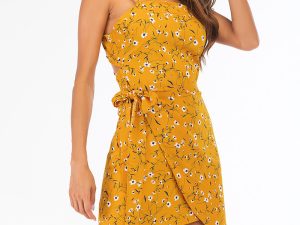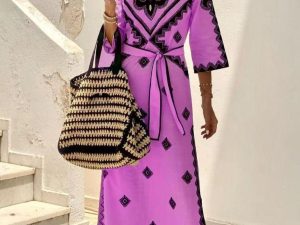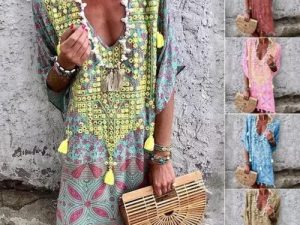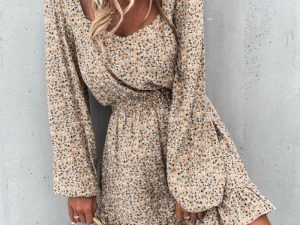Free shipping on all orders above $100
Dresses for DIY Projects: Easy Step-by-Step Guide

Table of Contents
Shop Boho Dresses
Finding the perfect dress for your next DIY project can be a game-changer. At Boho 70, we offer a wide selection of clothing that fits any creative endeavor. Whether you’re upcycling an old favorite or crafting a new masterpiece, our dresses provide the ideal canvas for your imagination.
When it comes to DIY projects, the right dress can make all the difference. Our collection at Boho 70 includes versatile options that are both stylish and functional. With our dresses, you’ll have the freedom to experiment and create something truly unique. Dive into our selection and discover how the perfect dress can inspire your next DIY adventure.
Key Takeaways
- Ideal Fabric Selection: Choosing the right fabric is crucial for a successful DIY dress project. Consider factors like comfort, durability, and fabric type, such as cotton, linen, silk, jersey knit, and denim.
- Essential Tools: Equip yourself with essential sewing tools like fabric scissors, measuring tape, tailor’s chalk, sewing machine, and thread to ensure precision and ease in the sewing process.
- Popular Dress Patterns: Explore popular dress patterns like A-Line, Wrap, and Shift dresses. Each pattern offers unique styling options suitable for different occasions and is beginner-friendly.
- Step-by-Step Guide: Follow a structured process for creating DIY dresses, starting with accurate measurements, followed by sewing basics and finishing touches to achieve a polished look.
- Customization Ideas: Personalize your dresses with techniques like embroidery, appliqué, dyeing, and fabric painting to add unique and artistic elements.
- Practical Tips and Tricks: Avoid common mistakes such as skipping measurements and overlooking seam allowances. Utilize tips like chain stitching and batch cutting to streamline your project and enhance professional results.
Choosing the Right Fabric
Selecting the ideal fabric significantly influences the success of your DIY dress project. The right material ensures comfort and durability and enhances the overall look.
Types of Fabric for DIY Dresses
- Cotton
Cotton is breathable and easy to sew. It’s perfect for beginners and versatile enough for various styles, such as casual dresses and summer wear. - Linen
Linen offers a natural look with a slightly textured finish. It’s airy and light, suitable for hot climates, although it wrinkles easily. - Silk
Silk is luxurious and has a natural sheen. It’s ideal for formal occasions but can be challenging to manage due to its slippery nature. - Jersey Knit
Jersey knit provides stretch and comfort, making it great for form-fitting dresses and casual wear. It often requires a serger for clean edges. - Denim
Denim is durable and ideal for structured dresses. It’s slightly challenging to sew, requiring heavy-duty needles.
- Feel the Fabric
Touch the material to assess comfort. Avoid fabrics that feel rough or scratchy unless the look outweighs comfort. - Check the Weave
Hold the fabric up to light to inspect for tightness of the weave. Tightly woven fabrics are generally more durable and hold their shape better. - Stretch Test
Stretch the fabric to see if it retains its shape. Fabrics that deform easily might not last long. - Drape Test
Drape the fabric over your hand to observe how it falls. This gives insight into how it’ll look when sewn into a dress. - Wrinkle Test
Squeeze a small section to check for wrinkles. High-quality fabrics generally wrinkle less and are easier to care for.
Tools You Will Need
Selecting the right tools is crucial for any DIY dress project. Below are essential and optional tools to get started.
Essential Sewing Tools
- Measuring Tape: Ensures precise measurements for accurate cutting and fitting.
- Fabric Scissors: Specialized scissors make clean cuts through fabric, avoiding fraying.
- Tailor’s Chalk or Fabric Markers: Marks fabric for cutting and stitching, easy to remove or wash out.
- Pins and Pincushion: Keeps fabric pieces in place while cutting and sewing.
- Sewing Machine: Streamlines the sewing process, ideal for both beginners and experts.
- Needles: Hand-sewing needles are essential for detailed work or fixing minor issues.
- Thread: Strong thread matches your fabric to maintain durability and aesthetics.
- Seam Ripper: Corrects any mistakes, allowing you to remove stitches without damaging the fabric.
- Iron and Ironing Board: Presses seams and hems for a polished, professional look.
- Rotary Cutter: Cuts fabric quickly and efficiently, especially useful for large projects.
- Cutting Mat: Protects surfaces from cuts and provides a work surface for cutting fabric.
- Pattern Weights: Holds patterns in place without pinning, making it easier to cut fabric accurately.
- Dress Form: Assists in fitting and adjusting garments, particularly useful for complex designs.
- Bias Tape Maker: Simplifies the creation of bias tape, a useful tool for finishing edges.
- Tracing Wheel and Carbon Paper: Transfers patterns onto fabric accurately, essential for detailed designs.
- Sewing Gauge: Measures small distances precisely, useful for hems and buttonholes.
- Loop Turner: Turns narrow tubes of fabric right-side-out, ideal for straps or belts.
Popular Dress Patterns
Here are some popular dress patterns you can try for your DIY projects. Each pattern has unique characteristics that make it perfect for different styles and occasions.
A-Line Dresses
A-line dresses feature a fitted bodice that gradually flares out from the waist, creating a silhouette that resembles the letter “A.” These dresses are versatile and flattering on many body types. Look for patterns that include darts or princess seams for a more tailored fit.
Wrap Dresses
Wrap dresses are known for their adjustable waist ties that wrap around the body, making them customizable to fit various shapes. They typically have a V-neckline and can be short or long. Patterns for wrap dresses often include instructions for creating a waist tie and securing the dress in place.
Shift Dresses
Shift dresses are simple, straight-cut dresses that hang loosely from the shoulders without a defined waist. They’re perfect for casual or semi-formal settings. Shift dress patterns usually require minimal fabric and sewing, making them ideal for beginners.
A huge selection of chic clothing is available at our online store, Boho 70. Visit the site now to find the perfect dress pattern for your next DIY project.
Step-by-Step Guide
Creating dresses for DIY projects can be an exciting and rewarding experience. Here are the essential steps to guide you through the process.
Measuring and Cutting
Accurate measurements ensure a perfect fit. First, I gather my measuring tape and note down all relevant measurements: bust, waist, hips, and length. Next, I lay my fabric on a flat surface and use fabric chalk to mark the measurements. Using a fabric ruler helps in drawing straight lines. Then, using fabric scissors, I cut along the marked lines, ensuring smooth edges to prevent fraying.
Sewing Basics
Before sewing, I thread my sewing machine and select a matching thread color. I pin the fabric pieces together, aligning the edges, and leave a small seam allowance. I start with a straight stitch for seams. For more flexibility, I use a zigzag stitch around the raw edges to prevent fraying. While sewing, I maintain a steady pace to keep stitches even.
Adding Finishing Touches
Finishing touches elevate the dress. I hem the bottom edge by folding the fabric twice and sewing a straight stitch. Adding buttons or zippers helps with closures. I also press the dress with an iron, focusing on seams, to achieve a polished look. When adding decorative elements like appliqués or embroidery, I choose ones that complement the dress style.
Customization Ideas
DIY dress projects offer endless possibilities for personalization. Here are some creative customization ideas to make your dresses truly unique:
Embroidery and Appliqué
Embroidery and appliqué add intricate details to any dress. Both techniques elevate simple fabrics by incorporating personal designs.
- Embroidery: Use needle and thread to create patterns on your dress. Consider floral motifs, geometric shapes, and monograms.
- Appliqué: Sew fabric pieces onto your dress to create textured designs. Examples include patches, lace overlays, and fabric cutouts.
Dyeing and Painting Techniques
Add color and artistic flair to your dresses with dyeing and painting. These techniques transform plain fabrics with vibrant hues and unique patterns.
- Tie-Dye: Twist and bind your fabric before applying dye to create unique patterns. Use multiple colors for a bold look.
- Fabric Painting: Use fabric paints and brushes to create detailed designs. Consider stencils, freehand painting, and block printing.
Tips and Tricks
In this section, I’ll share practical advice to make your DIY dress projects easier and more successful.
Common Mistakes to Avoid
- Skipping Measurements
Take accurate measurements to ensure a good fit. Using incorrect measurements can lead to wasted fabric and frustration. - Ignoring Fabric Grain
Align fabric pieces according to the grain. Ignoring the grain can cause pieces to stretch unevenly. - Choosing the Wrong Needle
Use the right needle for your fabric. A wrong needle can result in skipped stitches or fabric damage. - Overlooking Seam Allowances
Include seam allowances in your pattern pieces. This ensures the dress meets the expected size and fit. - Not Pre-washing Fabric
Pre-wash fabric to avoid shrinkage after sewing. Fabric that shrinks post-sewing can ruin your project.
- Use Pre-Cut Patterns
Pre-cut patterns save time on measuring and cutting. They ensure consistent results. - Chain Stitching
Sew multiple pieces without cutting the thread between them. This method saves thread and time. - Mark with Chalk
Use fabric chalk to mark patterns and lines. It’s quick, easy to see, and washes out. - Ironing While Sewing
Press seams as you sew. Pressing ensures smoother and more professional-looking seams. - Batch Cutting
Cut all pattern pieces at once. This step streamlines the sewing process and reduces repetitive tasks.
Find a wide selection of chic clothing at our online store, Boho 70. Visit Boho 70 today to discover stylish, unique garments that suit every taste and occasion.
Conclusion
Embarking on a DIY dress project can be incredibly rewarding. By selecting the right fabric and tools and following essential techniques like measuring accurately and using pre-cut patterns you can create beautiful and unique garments. Don’t forget the importance of customization to add your personal touch. If you’re looking for inspiration or ready-made stylish options check out Boho 70’s online store. Happy sewing!









